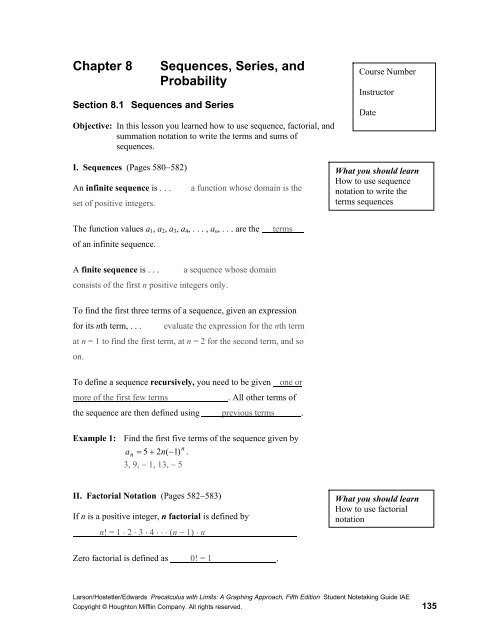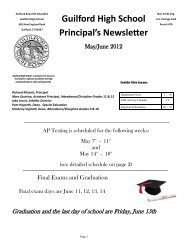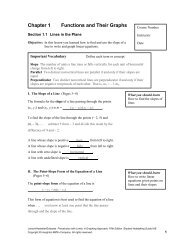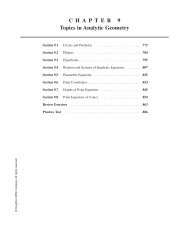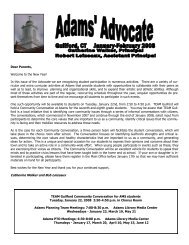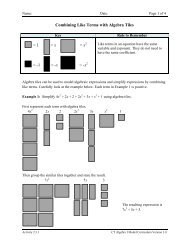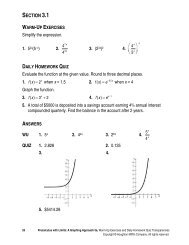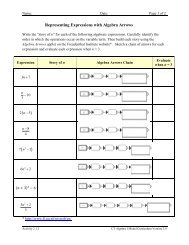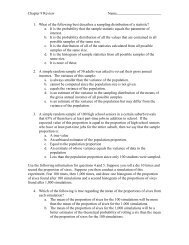chapter 8 student notes
chapter 8 student notes
chapter 8 student notes
You also want an ePaper? Increase the reach of your titles
YUMPU automatically turns print PDFs into web optimized ePapers that Google loves.
Chapter 8<br />
Sequences, Series, and<br />
Probability<br />
Section 8.1 Sequences and Series<br />
Objective: In this lesson you learned how to use sequence, factorial, and<br />
summation notation to write the terms and sums of<br />
sequences.<br />
Course Number<br />
Instructor<br />
Date<br />
I. Sequences (Pages 580−582)<br />
An infinite sequence is . . .<br />
set of positive integers.<br />
a function whose domain is the<br />
What you should learn<br />
How to use sequence<br />
notation to write the<br />
terms sequences<br />
The function values a 1 , a 2 , a 3 , a 4 , . . . , a n , . . . are the<br />
of an infinite sequence.<br />
terms<br />
A finite sequence is . . . a sequence whose domain<br />
consists of the first n positive integers only.<br />
To find the first three terms of a sequence, given an expression<br />
for its nth term, . . . evaluate the expression for the nth term<br />
at n = 1 to find the first term, at n = 2 for the second term, and so<br />
on.<br />
To define a sequence recursively, you need to be given one or<br />
more of the first few terms<br />
. All other terms of<br />
the sequence are then defined using previous terms .<br />
Example 1: Find the first five terms of the sequence given by<br />
a = 5 + 2n(<br />
−1)<br />
.<br />
n<br />
3, 9, − 1, 13, − 5<br />
n<br />
II. Factorial Notation (Pages 582−583)<br />
If n is a positive integer, n factorial is defined by<br />
n! = 1 ⋅ 2 ⋅ 3 ⋅ 4 ⋅ ⋅ ⋅ (n − 1) ⋅ n<br />
What you should learn<br />
How to use factorial<br />
notation<br />
Zero factorial is defined as 0! = 1 .<br />
Larson/Hostetler/Edwards Precalculus with Limits: A Graphing Approach, Fifth Edition Student Notetaking Guide IAE<br />
Copyright © Houghton Mifflin Company. All rights reserved. 135
136 Chapter 8 Sequences, Series, and Probability<br />
Example 2: Evaluate the factorial expression<br />
n!<br />
.<br />
( n + 1)!<br />
1/(n + 1)<br />
III. Summation Notation (Pages 584−585)<br />
The sum of the first n terms of a sequence is represented by the<br />
summation or sigma notation,<br />
n<br />
∑ a i<br />
i=<br />
1<br />
= a 1 + a 2 + a 3 + a 4 + . . . + a n<br />
where i is called the index of summation , n is the<br />
upper limit of summation , and 1 is the lower<br />
limit of summation .<br />
What you should learn<br />
How to use summation<br />
notation to write sums<br />
Example 3: Find the following sum: ∑ (2 + 3i ) .<br />
93<br />
7<br />
i=<br />
2<br />
IV. Series (Page 585)<br />
The sum of the terms of a finite or infinite sequence is called a<br />
series .<br />
What you should learn<br />
How to find sums of<br />
infinite series<br />
Consider the infinite sequence a 1 , a 2 , a 3 , . . . , a i , . . . . The sum of the<br />
first n terms of the sequence is called a(n) finite series or<br />
the partial sum of the sequence and is denoted by<br />
n<br />
∑<br />
a1 + a2<br />
+ a3<br />
+ + a n = a i . The sum of all terms of the infinite<br />
i=<br />
1<br />
sequence is called a(n) infinite series and is denoted by<br />
a<br />
1<br />
+ a<br />
2<br />
+ a<br />
3<br />
= ∑ ∞ + + a i + a i .<br />
=<br />
Homework Assignment<br />
Page(s)<br />
Exercises<br />
i 1<br />
Larson/Hostetler/Edwards Precalculus with Limits: A Graphing Approach, Fifth Edition Student Notetaking Guide IAE<br />
Copyright © Houghton Mifflin Company. All rights reserved.
Section 8.2 Arithmetic Sequences and Partial Sums 137<br />
Section 8.2 Arithmetic Sequences and Partial Sums<br />
Objective: In this lesson you learned how to recognize, write, and use<br />
arithmetic sequences.<br />
Course Number<br />
Instructor<br />
Date<br />
Important Vocabulary<br />
Define each term or concept.<br />
Arithmetic sequence A sequence in which the differences between consecutive terms<br />
are the same.<br />
I. Arithmetic Sequences (Pages 592−594)<br />
The common difference of an arithmetic sequence is . . .<br />
difference d between consecutive terms of an arithmetic<br />
sequence. That is, d = a 2 – a 1 = a 3 – a 2 = a 4 – a 3 = …<br />
the<br />
What you should learn<br />
How to recognize, write,<br />
and find the nth terms of<br />
arithmetic sequences<br />
The nth term of an arithmetic sequence has the form<br />
a n = dn + c<br />
, where d is the common difference<br />
between consecutive terms of the sequence, and c = a 1 − d. An<br />
arithmetic sequence an<br />
= dn+ c can be thought of as counting<br />
by d’s after a shift of c units from d .<br />
Example 1: Determine whether or not the following sequence<br />
is arithmetic. If it is, find the common difference.<br />
7, 3, − 1, − 5, − 9, . . .<br />
Yes; − 4<br />
Example 2: Find a formula for the nth term of the arithmetic<br />
sequence whose common difference is 2 and<br />
whose first term is 7.<br />
a n = 2n + 5<br />
The nth term of an arithmetic sequence has the alternative<br />
recursion formula a n = a 1 + (n − 1)d .<br />
Example 3: Find the sixth term of the arithmetic sequence that<br />
begins with 15 and 12.<br />
0<br />
Larson/Hostetler/Edwards Precalculus with Limits: A Graphing Approach, Fifth Edition Student Notetaking Guide IAE<br />
Copyright © Houghton Mifflin Company. All rights reserved.
138 Chapter 8 Sequences, Series, and Probability<br />
II. The Sum of a Finite Arithmetic Sequence<br />
(Pages 595−596)<br />
The sum of a finite arithmetic sequence with n terms is given by<br />
S n = n/2(a 1 + a n ) .<br />
What you should learn<br />
How to find nth partial<br />
sums of arithmetic<br />
sequences<br />
The sum of the first n terms of an infinite sequence is called the<br />
nth partial sum .<br />
Example 4: Find the sum of the first 20 terms of the sequence<br />
with nth term a n = 28 − 5n<br />
.<br />
− 490<br />
III. Applications of Arithmetic Sequences (Pages 596−597)<br />
Describe a real-life problem that could be solved by finding the<br />
sum of a finite arithmetic sequence.<br />
Answers will vary.<br />
What you should learn<br />
How to use arithmetic<br />
sequences to model and<br />
solve real-life problems<br />
Additional <strong>notes</strong><br />
Homework Assignment<br />
Page(s)<br />
Exercises<br />
Larson/Hostetler/Edwards Precalculus with Limits: A Graphing Approach, Fifth Edition Student Notetaking Guide IAE<br />
Copyright © Houghton Mifflin Company. All rights reserved.
Section 8.3 Geometric Sequences and Series 139<br />
Section 8.3 Geometric Sequences and Series<br />
Objective: In this lesson you learned how to recognize, write, and use<br />
geometric sequences.<br />
Course Number<br />
Instructor<br />
Date<br />
Important Vocabulary<br />
Define each term or concept.<br />
Geometric sequence A sequence in which the ratios of consecutive terms are the<br />
same.<br />
Infinite geometric series or geometric series The sum of the terms of an infinite<br />
geometric sequence.<br />
I. Geometric Sequences (Pages 601−603)<br />
The common ratio of a geometric sequence is . . . the ratio r<br />
between consecutive terms of a geometric sequence. That is,<br />
r = a 2 /a 1 = a 3 /a 2 = a 4 /a 3 = . . . , r ≠ 0.<br />
What you should learn<br />
How to recognize, write,<br />
and find the nth terms of<br />
geometric sequences<br />
The nth term of a geometric sequence has the form<br />
a n = a 1 r n−1 , where r is the common ratio of<br />
consecutive terms of the sequence. So, every geometric sequence<br />
can be written in the following form:<br />
a 1 , a 1 r, a 1 r 2 , a 1 r 3 , a 1 r 4 , . . . , a 1 r n−1 , . . . .<br />
If you know the nth term of a geometric sequence, you can find<br />
the (n + 1)th term by multiplying by r . That is,<br />
a +<br />
= a n r .<br />
n 1<br />
Example 1: Determine whether or not the following sequence<br />
is geometric. If it is, find the common ratio.<br />
60, 30, 0, − 30, − 60, . . .<br />
No<br />
Example 2: Write the first five terms of the geometric<br />
sequence whose first term is a 1 = 5 and whose<br />
common ratio is − 3.<br />
5, − 15, 45, − 135, 405<br />
Example 3: Find the eighth term of the geometric sequence<br />
that begins with 15 and 12.<br />
3.145728<br />
Larson/Hostetler/Edwards Precalculus with Limits: A Graphing Approach, Fifth Edition Student Notetaking Guide IAE<br />
Copyright © Houghton Mifflin Company. All rights reserved.
140 Chapter 8 Sequences, Series, and Probability<br />
II. The Sum of a Finite Geometric Sequence (Page 604)<br />
The sum of the geometric sequence a 1 , a 1 r, a 1 r 2 , a 1 r 3 , a 1 r 4 , . . .,<br />
a 1 r n−1 with common ratio r ≠ 1 is given by<br />
S n = a 1 (1 − r n )/(1 − r) .<br />
What you should learn<br />
How to find nth partial<br />
sums of geometric<br />
sequences<br />
When using the formula for the sum of a geometric sequence, be<br />
careful to check that the index begins with i = 1. If the index<br />
begins at i = 0, . . . you must adjust the formula for the nth<br />
partial sum.<br />
Example 4: Find the sum ∑ 2(0.5)<br />
1.998046875<br />
10<br />
i=<br />
1<br />
i .<br />
III. Geometric Series (Pages 605−606)<br />
If | r | < 1, then the infinite geometric series a 1 + a 1 r + a 1 r 2 + a 1 r 3<br />
+ a 1 r 4 + . . . + a 1 r n−1 + . . . has the sum S = a 1 /(1 − r) .<br />
What you should learn<br />
How to find sums of<br />
infinite geometric series<br />
If r ≥ 1 , the series does not have a sum.<br />
Example 5: If possible, find the sum: ∑ ∞<br />
=<br />
12<br />
i 1<br />
9(0.25)<br />
i−1<br />
.<br />
IV. Applications of Geometric Sequences (Page 606)<br />
Describe a real-life problem that could be solved by finding the<br />
sum of a finite geometric sequence.<br />
Answers will vary.<br />
What you should learn<br />
How to use geometric<br />
sequences to model and<br />
solve real-life problems<br />
Homework Assignment<br />
Page(s)<br />
Exercises<br />
Larson/Hostetler/Edwards Precalculus with Limits: A Graphing Approach, Fifth Edition Student Notetaking Guide IAE<br />
Copyright © Houghton Mifflin Company. All rights reserved.
Section 8.4 Mathematical Induction 141<br />
Section 8.4 Mathematical Induction<br />
Objective: In this lesson you learned how to use mathematical induction<br />
to prove statements involving a positive integer n.<br />
Course Number<br />
Instructor<br />
Date<br />
Important Vocabulary<br />
Define each term or concept.<br />
Mathematical induction A form of mathematical proof in which it must be shown<br />
for a statement, P n , involving the positive integer n, that if P 1 is true and that the truth<br />
of P k implies the truth of P k+1 for every positive k, then P n must be true for all positive<br />
integers n.<br />
I. Introduction (Pages 611−614)<br />
To apply the Principle of Mathematical Induction, you need to<br />
be able to determine the statement P k+1 for a<br />
given statement P k .<br />
What you should learn<br />
How to use mathematical<br />
induction to prove<br />
statements involving a<br />
positive integer n<br />
When using mathematical induction to prove a summation<br />
formula, it is helpful to think of S k+1 as . . .<br />
S k+1 = S k + a k+1 where a k+1 is the (k + 1)th term of the original<br />
sum.<br />
Describe the process needed to prove a formula using<br />
mathematical induction.<br />
Mathematical induction consists of two distinct parts. First, you<br />
must show that the formula is true when n = 1. The second part<br />
of mathematical induction has two steps. The first step is to<br />
assume that the formula is valid for some integer k. The second<br />
step is to use this assumption to prove that the formula is valid<br />
for the next integer, k + 1. Combining the results of the first and<br />
second parts, you can conclude by mathematical induction that<br />
the formula is valid for all positive integer values of n.<br />
The extended principle of mathematical induction is . . .<br />
a slight variation of the Principle of Mathematical Induction in<br />
which a statement P n is proved true for n ≥ k by verifying P k ,<br />
rather than P 1 .<br />
Larson/Hostetler/Edwards Precalculus with Limits: A Graphing Approach, Fifth Edition Student Notetaking Guide IAE<br />
Copyright © Houghton Mifflin Company. All rights reserved.
142 Chapter 8 Sequences, Series, and Probability<br />
II. Sums of Powers of Integers (Page 615)<br />
List the formulas for the following sums of powers of integers.<br />
1. 1 + 2 + 3 + 4 + + n = n(n + 1)/2<br />
What you should learn<br />
How to find the sums of<br />
powers of integers<br />
2<br />
2<br />
2<br />
2<br />
2. 1 + 2 + 3 + 4 + + n = n(n + 1)(2n + 1)/6<br />
3<br />
3<br />
3<br />
3<br />
3. 1 + 2 + 3 + 4 + + n =<br />
n 2 (n + 1) 2 /4<br />
4<br />
4<br />
4<br />
4<br />
3<br />
2<br />
4<br />
4. 1 + 2 + 3 + 4 + + n = n(n + 1)(2n + 1)(3n 2 + 3n − 1)/30<br />
5<br />
5<br />
5<br />
5<br />
5<br />
5. 1 + 2 + 3 + 4 + + n = n 2 (n + 1) 2 (2n 2 + 2n − 1)/12<br />
III. Finite Differences (Page 616)<br />
First differences are . . . found by subtracting consecutive<br />
terms of a sequence.<br />
What you should learn<br />
How to find finite<br />
differences of sequences<br />
If the first differences of a sequence are all the same nonzero<br />
number, the sequence has a linear model, that is<br />
arithmetic .<br />
Second differences are . . .<br />
consecutive first differences.<br />
are found by subtracting<br />
When the second differences of a sequence are all the same and<br />
nonzero, the sequence has a perfect quadratic model.<br />
Homework Assignment<br />
Page(s)<br />
Exercises<br />
Larson/Hostetler/Edwards Precalculus with Limits: A Graphing Approach, Fifth Edition Student Notetaking Guide IAE<br />
Copyright © Houghton Mifflin Company. All rights reserved.
Section 8.5 The Binomial Theorem 143<br />
Section 8.5 The Binomial Theorem<br />
Objective: In this lesson you learned how to use the Binomial Theorem<br />
and Pascal’s Triangle to calculate binomial coefficients and<br />
write binomial expansions.<br />
Course Number<br />
Instructor<br />
Date<br />
Important Vocabulary<br />
Define each term or concept.<br />
Binomial coefficients The coefficients of a binomial expansion.<br />
Pascal’s Triangle A triangular pattern, named for the French mathematician Blaise<br />
Pascal, in which the first and last numbers in each row are 1and every other number in<br />
each row is formed by adding the two numbers immediately above the number. These<br />
numbers are precisely the same as the coefficients of binomial expansions.<br />
I. Binomial Coefficients (Pages 619−620)<br />
List four general observations about the expansion of<br />
for various values of n.<br />
1) In each expansion, there are n + 1 terms.<br />
( x + y)<br />
n<br />
What you should learn<br />
How to use the Binomial<br />
Theorem to calculate<br />
binomial coefficients<br />
2) In each expansion, x and y have symmetric roles. The powers of x<br />
decrease by 1 in successive terms, whereas the powers of y increase by 1.<br />
3) The sum of the powers in each term is n.<br />
4) The coefficients increase and then decrease in a symmetric pattern.<br />
The Binomial Theorem states that in the expansion of (x + y) n =<br />
x n + nx n – 1 y + . . . + n C r x n – r y r + . . . + nxy n – 1 + y n , the coefficient<br />
of x n – r y r is nC r = n!/((n − r)!r!) .<br />
Example 1: Find the binomial coefficient 12 C 5 .<br />
792<br />
II. Binomial Expansions (Pages 621−622)<br />
Writing out the coefficients for a binomial that is raised to a<br />
power is called expanding a binomial .<br />
What you should learn<br />
How to use binomial<br />
coefficients to write<br />
binomial expansions<br />
Example 2: Write the expansion of the expression<br />
x 5 + 10x 4 + 40x 3 + 80x 2 + 80x + 32<br />
5<br />
( x + 2) .<br />
Larson/Hostetler/Edwards Precalculus with Limits: A Graphing Approach, Fifth Edition Student Notetaking Guide IAE<br />
Copyright © Houghton Mifflin Company. All rights reserved.
144 Chapter 8 Sequences, Series, and Probability<br />
III. Pascal’s Triangle (Page 623)<br />
Construct rows 0 through 6 of Pascal’s Triangle.<br />
1<br />
1 1<br />
1 2 1<br />
1 3 3 1<br />
1 4 6 4 1<br />
1 5 10 10 5 1<br />
1 6 15 20 15 6 1<br />
What you should learn<br />
How to use Pascal’s<br />
Triangle to calculate<br />
binomial coefficients<br />
Additional <strong>notes</strong><br />
Homework Assignment<br />
Page(s)<br />
Exercises<br />
Larson/Hostetler/Edwards Precalculus with Limits: A Graphing Approach, Fifth Edition Student Notetaking Guide IAE<br />
Copyright © Houghton Mifflin Company. All rights reserved.
Section 8.6 Counting Principles 145<br />
Section 8.6 Counting Principles<br />
Objective: In this lesson you learned how to solve counting problems<br />
using the Fundamental Counting Principle, permutations,<br />
and combinations.<br />
Course Number<br />
Instructor<br />
Date<br />
Important Vocabulary<br />
Define each term or concept.<br />
Fundamental Counting Principle Let E 1 and E 2 be two events. The first event E 1<br />
can occur in m 1 different ways. After E 1 has occurred, E 2 can occur in m 2 different<br />
ways. The number of ways that the two events can occur is m 1 ⋅ m 2 .<br />
Permutation An ordering of n different elements such that one element is first, one is<br />
second, one is third, and so on.<br />
Distinguishable permutations Suppose a set of n objects has n 1 of one kind of<br />
object, n 2 of a second kind, n 3 of a third kind, and so on, with n = n 1 + n 2 + n 3 + . . . +<br />
n k . Then the number of distinguishable permutations of the n objects is given by<br />
n!/(n 1 !⋅n 2 !⋅n 3 !⋅ ⋅ ⋅ ⋅ n k !).<br />
I. Simple Counting Problems (Page 627)<br />
If two balls are randomly drawn from a bag of six balls,<br />
numbered from 1 to 6, such that it is possible to choose two 3’s,<br />
the random selection occurs with replacement . If<br />
two balls are drawn from the bag at the same time, the random<br />
selection occurs without replacement , which<br />
eliminates the possibility of choosing two 3’s.<br />
What you should learn<br />
How to solve simple<br />
counting problems<br />
II. The Fundamental Counting Principle (Page 628)<br />
The Fundamental Counting Principle can be extended to three or<br />
more events. For instance, if E 1 can occur in m 1 ways, E 2 in m 2<br />
ways, and E 3 in m 3 ways, the number of ways that three events<br />
E 1 , E 2 , and E 3 can occur is m 1 ⋅ m 2 ⋅ m 3 .<br />
What you should learn<br />
How to use the<br />
Fundamental Counting<br />
Principle to solve more<br />
complicated counting<br />
problems<br />
Example 1: A diner offers breakfast combination plates which<br />
can be made from a choice of one of 4 different<br />
types of breakfast meats, one of 8 different styles<br />
of eggs, and one of 5 different types of breakfast<br />
breads. How many different breakfast combination<br />
plates are possible?<br />
160 different combinations<br />
Larson/Hostetler/Edwards Precalculus with Limits: A Graphing Approach, Fifth Edition Student Notetaking Guide IAE<br />
Copyright © Houghton Mifflin Company. All rights reserved.
146 Chapter 8 Sequences, Series, and Probability<br />
III. Permutations (Pages 629−631)<br />
The number of different ways that n elements can be ordered is<br />
n! .<br />
What you should learn<br />
How to use permutations<br />
to solve counting<br />
problems<br />
A permutation of n elements taken r at a time is . . .<br />
an ordering of subset of a collection of n elements, rather than<br />
the entire collection, for example, choosing and ordering r<br />
elements out of a collection of n elements. The number of n<br />
elements taken r at a time is given by n P r = n!/(n − r)! .<br />
Example 2: In how many ways can a chairperson, a vice<br />
chairperson, and a recording secretary be chosen<br />
from a committee of 14 people?<br />
2184 ways<br />
Example 3: In how many distinguishable ways can the letters<br />
COMMITTEE be written?<br />
45,360 ways<br />
IV. Combinations (Pages 632−633)<br />
A combination of n elements taken r at a time is . . .<br />
a subset of a larger set in which the order is not important. The<br />
number of combinations of n elements taken r at a time is given<br />
by n C r = n!/((n − r)! r!).<br />
What you should learn<br />
How to use combinations<br />
to solve counting<br />
problems<br />
Example 4: In how many ways can a research team of 3<br />
<strong>student</strong>s be chosen from a class of 14 <strong>student</strong>s?<br />
364 ways<br />
Homework Assignment<br />
Page(s)<br />
Exercises<br />
Larson/Hostetler/Edwards Precalculus with Limits: A Graphing Approach, Fifth Edition Student Notetaking Guide IAE<br />
Copyright © Houghton Mifflin Company. All rights reserved.
Section 8.7 Probability 147<br />
Section 8.7 Probability<br />
Objective: In this lesson you learned how to find the probability of<br />
events and their complements.<br />
Course Number<br />
Instructor<br />
Date<br />
Important Vocabulary<br />
Define each term or concept.<br />
Independent events Two events are independent if the occurrence of one has no<br />
effect on the occurrence of the other.<br />
Complement of an event The collection of all outcomes in the sample space that are<br />
not in the event.<br />
I. The Probability of an Event (Pages 637−640)<br />
Any happening whose result is uncertain is called a(n)<br />
experiment . The possible results of the experiment<br />
are outcomes , the set of all possible outcomes of<br />
the experiment is the sample space of the<br />
experiment, and any subcollection of a sample space is a(n)<br />
event .<br />
What you should learn<br />
How to find probabilities<br />
of events<br />
To calculate the probability of an event, . . . count the number<br />
of outcomes in the event, n(E), and in the sample space, n(S).<br />
If an event E has n(E) equally likely outcomes and its sample<br />
space S has n(S) equally likely outcomes, the probability of<br />
event E is given by P(E) = n(E)/n(S) .<br />
The probability of an event must be between 0 and<br />
1 .<br />
If P(E) = 0, the event E cannot occur, and E is called<br />
a(n) impossible event. If P(E) = 1, the event E<br />
must occur, and E is called a(n) certain<br />
event.<br />
Example 1: A box contains 3 red marbles, 5 black marbles,<br />
and 2 yellow marbles. If a marble is selected at<br />
random from the box, what is the probability that<br />
it is yellow?<br />
1/5<br />
Larson/Hostetler/Edwards Precalculus with Limits: A Graphing Approach, Fifth Edition Student Notetaking Guide IAE<br />
Copyright © Houghton Mifflin Company. All rights reserved.
148 Chapter 8 Sequences, Series, and Probability<br />
II. Mutually Exclusive Events (Pages 641−642)<br />
Two events A and B (from the same sample space) are mutually<br />
exclusive if A and B have no outcomes in common.<br />
What you should learn<br />
How to find probabilities<br />
of mutually exclusive<br />
events<br />
If A and B are events in the same sample space, the probability of<br />
A or B occurring is given by P(A ∪ B) = P(A) + P(B) − P(A ∩ B) .<br />
To find the probability that one or the other of two mutually<br />
exclusive events will occur, . . . add their individual<br />
probabilities.<br />
Example 2: A box contains 3 red marbles, 5 black marbles,<br />
and 2 yellow marbles. If a marble is selected at<br />
random from the box, what is the probability that<br />
it is either red or black?<br />
4/5<br />
III. Independent Events (Page 643)<br />
If A and B are independent events, the probability that both A<br />
and B will occur is P(A and B) = P(A) ⋅ P(B) .<br />
What you should learn<br />
How to find probabilities<br />
of independent events<br />
That is, to find the probability that two independent events will<br />
occur, . . . multiply the probabilities of each event.<br />
Example 3: A box contains 3 red marbles, 5 black marbles,<br />
and 2 yellow marbles. If two marbles are<br />
randomly selected with replacement, what is the<br />
probability that both marbles are yellow?<br />
1/25<br />
IV. The Complement of an Event (Page 644)<br />
Let A be an event and let A′ be its complement. If the probability<br />
of A is P(A), the probability of the complement is<br />
P(A′) = 1 − P(A) .<br />
What you should learn<br />
How to find probabilities<br />
of complements of events<br />
Homework Assignment<br />
Page(s)<br />
Exercises<br />
Larson/Hostetler/Edwards Precalculus with Limits: A Graphing Approach, Fifth Edition Student Notetaking Guide IAE<br />
Copyright © Houghton Mifflin Company. All rights reserved.


